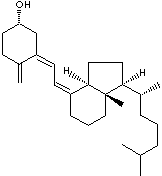| CAS
NO. |
67-97-0
8024-19-9 8050-67-7 |

|
| EINECS
NO. |
200-673-2 |
| FORMULA |
C27H44O |
| MOL
WT. |
384.64 |
|
H.S.
CODE
|
|
|
TOXICITY
|
|
| DERIVATION |
|
| SYNONYMS |
9,10-Seco(5Z,7E)-5,7,10(19)-cholestatrien-3-ol
|
| Cholecalciferolum
Colecalciferol Colecalciferolo Colecalciferolum Colecalcipherol 9,10-Seco(5Z,7E)-5,7,10(19)-cholestatrien-3-ol 9,10-Secocholesta-5,7,10(19)-trien-3-beta-ol Activated 7-dehydrocholesterol Arachitol Vitamin D3 |
|
CLASSIFICATION
|
|
|
PHYSICAL AND CHEMICAL PROPERTIES
|
| PHYSICAL
STATE |
white crystalline powder |
| MELTING POINT |
84 - 87 C |
| BOILING
POINT |
|
| SPECIFIC GRAVITY |
|
| SOLUBILITY
IN WATER |
Insoluble (soluble in alcohol, chloroform, acetone, ether, fatty oils) |
| pH |
|
| VAPOR DENSITY |
|
|
AUTOIGNITION
|
|
|
NFPA
RATINGS
|
|
|
REFRACTIVE
INDEX
|
|
| FLASH
POINT |
|
| STABILITY |
Stable
under ordinary conditions. |
|
GENERAL
DESCRIPTION & APPLICATIONS
|
Phytosterol: various sterols naturally obtained from plants. It is chemically similar to cholesterol which is obtained from animals. Sterol consists of three fused cyclohexane rings with hydrophenanthrene ring arrangement the side chains vary sterols (more than 40 phytosterols are known). Beta-sitosterol is the most abundant phytosterol and others include campesterol, stigmasterol, ergosterol, brassicasterol, delta-7-stigmasterol and delta-7-avenasterol. They are waxy, clear solids soluble in most organic solvents but insoluble in water, and contain one alcohol functional group. Sitosterols are considered to play roles in lowering cholesterol in body (anticholesterolemic agent). stigmasterol is an unsaturated plant sterol occurring in plant fats like such as calabar bean, soybean oil, rape seed and cocoa butter. It is used as a starting material in the manufacture of synthetic progesterone, a female sex hormone that plays an important physiological role to regularize and rebuild changes to the body caused by estrogen as well as in the luteal phase of the menstrual cycle. Its levels vary during the menstrual cycle. In addition, progesterone is used as an intermediate in the biosynthesis of androgens, estrogens, and the corticoids. Synthetic compounds with progesterone are used in the prevention of miscarriage, in the treatment of menstrual disorders. Ergosterol, also called provitamin D2,
is an unsaponifiable lipids found in ergot, yeast, and other fungi a white crystalline compound insoluble in water and soluble in organic solvents. It is converted to ergocalciferol (vitamin D2) upon irradiation by ultraviolet light or electronic bombardment. vitamin D is either of two fat-soluble sterol-like compounds with antirachitic activity, or both collectively: ergocalciferol (vitamin D2) and activated cholecalciferol (vitamin D3). Ergocalciferol is formed from the irradiation of ergosterol found in dietary supplements such as fish liver oils, egg yolks, and fortified dairy products. Whereas, cholecalciferol is normally synthesized in the skin, where ultraviolet light activates the compound 7-dehydrocholesterol. Vitamins D2 and D3 are about equal in activity in all mammals. Deficiency of vitamin D can result in rickets in children and osteomalacia in adults, while ingestion of excess levels can lead to hypercalcemia, mobilization of calcium from bone, and renal dysfunction. Vitamin D can be classified:
- Vitamin D1: Ergocalciferol compounded with Lumisterol
- Vitamin D2: Ergocalciferol
- Vitamin D3: Cholecalciferol
- Vitamin D4: 22,23-Dihydroergocalciferol
- Vitamin D5: Activated form of 7-Dehydrositosterol
|
| SALES
SPECIFICATION |
|
APPEARANCE
|
white crystalline powder |
|
ASSAY
|
97.0 - 103.0% (38,800,000 - 41,200,000 IU/G)
|
|
Light absorption |
465 - 495 |
|
OPTICAL ROTATION
|
+105°
~ +112° (in absolute ethanol) |
| TRANSPORTATION |
| PACKING |
|
| HAZARD CLASS |
6.1 (Packing Group: II) |
| UN
NO. |
2811 |
| OTHER
INFORMATION |
Hazard Symbols: T+, Risk Phrases: 24/25-26-48/25, Safety Phrases: 28-36/37
Equivalence to 1 IU(International unit) of each vitamins
|
VITAMIN
|
WT of biological ingredient
|
|
Vitamin A
|
3/10 μg Retinol, or 3/5 μg beta-Carotene
|
|
Vitamin C
|
50 μg Ascorbic acid
|
|
Vitamin D
|
1/40 μg Cholecalciferol or Ergocalciferol
|
|
Vitamin E
|
2/3 mg of D-alpha-Tocopherol or 1 mg of DL-alpha-Tocopherol acetate
|
|
